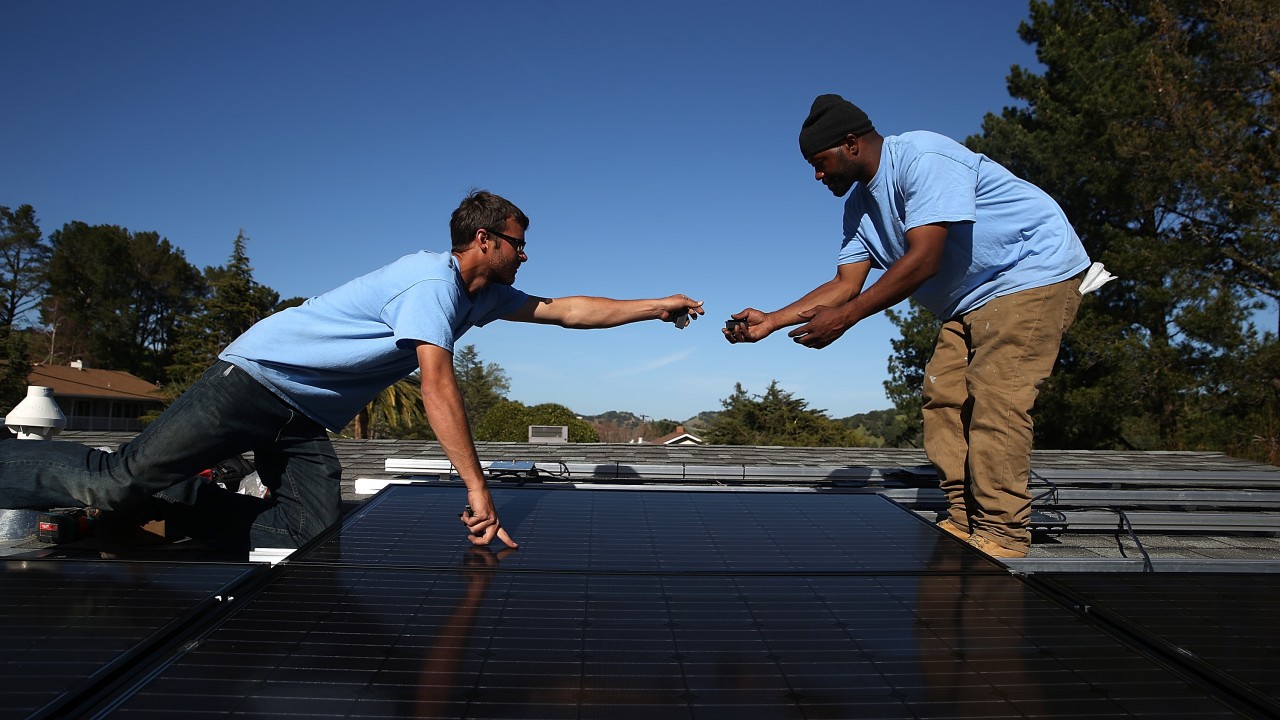
SolarCraft workers Craig Powell (L) and Edwin Neal install solar panels on the roof of a home on February 26, 2015 in San Rafael, California. According to a survey report by the Solar Foundation, the solar industry employs more workers than coal mining with nearly 174,000 people working in solar compared to close to 80,000 mining coal. (Photo by Justin Sullivan/Getty Images)
This post originally appeared at Yes! Magazine.
Our lifestyle is inextricably linked to fossil fuels. We pay the industry to heat our homes and power our cars. Though driving might be optional where public transit is available, heat is not during harsh winters. We know about the effects on the climate of burning oil, gas and coal for energy, but we don’t know what turning our backs on them will do to our economy. Some worry that closing our oil refineries and shutting down our mines would throw the market into a dangerous vortex. That doesn’t need to be the case. A successful energy transition could actually benefit the economy and reduce inequality.
The economy relies on a number of things, including spending, manufacturing, trade and personal income. The availability of fossil fuels has largely driven these for 150 years. “[Oil] is the world’s first trillion-dollar industry in terms of annual dollar sales,” environmental author Jack Doyle wrote in 1994. In North Dakota, a major oil — and gas-producing state, an oil boom created the $53.7 billion gross domestic product the state sees today.
But booms often have downsides. When the journal Energy Economics compared six states that produced the vast majority of the West’s crude oil and natural gas, it saw per capita income decrease by as much as $7,000 in counties whose incomes relied most on such development. Also, the crime rates and percentage of adults without a college education increased in those counties. The study offers possible explanations, including an increasing reliance on nonlocal workers and changing wage structures.
The oil and gas industries are the largest industrial sources of volatile organic compound emissions — 2.2 million tons a year. These chemicals cause smog, which can increase the risks of asthma and premature death. The industry also produces cancer-causing pollutants: benzene, ethylbenzene and n-hexane, which are emitted during the refinement process.
Low-income communities of color disproportionately bear this health burden and are also least likely to have access to health care, including preventive medicine, checkups and prescription drugs. The inequality of care only widens the income gap by adding more financial pressures to an already stressed group.
What about jobs? Extractive industries currently employ nearly 200,000 Americans and pay some employees as much as $42.90 an hour. These jobs are a valid concern. The US unemployment rate is finally down to about 5 percent. Surely we don’t want all those people put out of work.
That won’t happen if we launch the renewable energy sector in sync. Economists at the University of Massachusetts Amherst’s Political Economy Research Institute (PERI) have studied this topic since the early 2000s. Their research shows how a transition to renewables can lead to a post-carbon world and a fairer economy.
Robert Pollin, PERI’s co-director, began researching green job opportunities about seven years ago. In 2014, he and a few of his colleagues released Green Growth: A US Program for Controlling Climate Change and Expanding Job Opportunities, which looked at the economic potential of a renewable energy sector if the United States worked toward the emissions-reduction goal that the Intergovernmental Panel on Climate Change has proposed. This means reducing CO2 emissions by 40 percent over the next 20 years.
According to PERI, a renewable energy transition would be chock-full of jobs — about 2.7 million new ones. Pollin is quick to point out that these jobs wouldn’t require any more public or private investment dollars, as the model the report used looked at moving current fossil-fuel investments toward renewables.
This is just one part of the equation. A transition toward clean energy would also create more new jobs than dirty energy currently does. Comparing the two sectors, Green Growth shows that renewables create an average of 12.6 jobs per $1 million in investment. Oil, coal and gas, on the other hand, average about 10.6.
The study highlights that a transition should include energy efficiency, too. The labor necessary to retrofit and improve infrastructure would add another 14.6 jobs per $1 million in investment. And coupling the transition with energy efficiency updates would address a concern we see with fossil fuels and renewables: that communities lacking these energy sources would miss out on jobs. Not all communities are rich in sun, wind or oil, but every US community is poor in efficient infrastructure.
The transition away from fossil fuels would offer a wide range of jobs, Pollin explained. There will be something for people with and without high school diplomas, those who have partial college educations or college degrees, and some with post-college credentials. This means more engineers, more construction workers, more lawyers and more truck drivers. Building the green economy requires more people per dollar of expenditure than maintaining the fossil fuel economy, he said.
Labor-intensive employment sectors, like renewables, can decrease inequality by creating employment opportunities for the poor. The fossil fuel industry, on the other hand, invests more on machines and tools than hiring employees.
Robin Hahnel, a director of the Economics for Equity and the Environment Network, says the job market needs a huge transformation: a program similar to President Franklin D. Roosevelt’s New Deal, a series of federal programs that created jobs and labor laws during the Great Depression.
As seen with the New Deal, economic success isn’t just about the jobs; it’s about the policies that accompany them, too. An energy transition would help our economy, but it wouldn’t necessarily reduce poverty or inequality. At least not by itself.
That’s where James Boyce, PERI’s director of its Program on Development, Peacebuilding and the Environment, comes in. His economic research focuses on poverty reduction and environmental protection and has led him to support a cap-and-dividend program. Like cap and trade, this sets an annually decreasing limit to the amount of carbon companies that use carbon-based fuel can emit. It then requires those companies to purchase permits to match their emissions. But, unlike cap and trade, these permits can’t be exchanged if an emitter reaches its limit. The dividends — collected from the sales of the permits — are given back to the people as rebates. Every man, woman and child.
Critics say that the policy isn’t aggressive enough, that we would still be emitting. They also say cap and dividend doesn’t provide incentives to move toward renewables. To that, Boyce responds: “Cap and dividend would raise the price of oil, coal and natural gas. As prices go up, households and businesses consume less. The fact of higher prices, and the knowledge that prices will rise further as the cap tightens, is the key incentive that will spur investment in renewables and energy efficiency.”
These higher prices would be offset by the dividends, so people are more likely to accept the idea. These people include politicians. Bipartisan support is critical. “Climate policy is not something you can pass one fine day, and then the problem is solved,” Boyce explains. “We’re going to have to maintain the policy in place for three or four decades during the clean energy transition, and that means it has to be popular, right?”
The idea should be most popular among low-income households. Even though increased energy costs would take a larger portion of their income compared to high-earning households, Boyce’s research shows low-income households ultimately win. The poor consume much less energy than the rich, so once the dividends are distributed, they would see a nearly 15 percent increase in their net incomes. The net incomes of the rich would decrease by 2.4 percent because of their higher energy consumption. This is according to a model Boyce created, where the permits cost $200 per ton of emissions.
Ideas similar to cap and dividend are gaining traction in states like Oregon and on the federal level with bills like the Healthy Climate and Family Security Act of 2015 and the Managed Carbon Price Act of 2014. Alaska already has a dividend program, which pays residents yearly, based on oil extraction in the state.
So — about oil. This is where environmentalists and workers sometimes disagree. What will happen to people already employed by oil and gas? How would a renewable energy transition be more equal if it disproportionately affects the current energy sector?
Well, let’s make it a just transition.
Jeremy Brecher co-founded the Labor Network for Sustainability in 2009 with that transition in mind. He recognized that environmentalists and fossil fuel industry workers could solve climate change and inequality working together, but not if they treated one another as opposition.
“Any job is important if it is your job,” Brecher emphasizes. If fossil fuel employees feel their livelihood is being threatened, they’ll likely “serve as poster children for people who oppose climate protection for other reasons.” They’ll support the renewable energy revolution’s millions of new jobs as long as they get first dibs.
President Barack Obama apparently sees that logic. He included a $55 million plan for declining coal communities in his 2016 budget. The POWER (Partnerships for Opportunity and Workforce and Economic Revitalization) Plus Plan invests in workers, communities and their health. Funding is devoted to increasing job opportunities through training and cleanup of hazardous sites for communities to redevelop.
This is the sort of policy Brecher approves of. However, he would like to see a program go as far as the GI Bill of Rights, with employees eligible for full wages and benefits for at least three years, education and training expenses (including tuition and living) for up to four years, and decent pensions with health care for those ready to retire.
“Those commitments need to be available to coal miners and others who have made incredible sacrifices to their health and well-being in order to produce energy that we have all had our lives based on,” Brecher says.
It’s debatable whether the public or industry should finance those programs, but Brecher still gives credit where it’s due. Justice made it into the national political agenda. That’s something.




